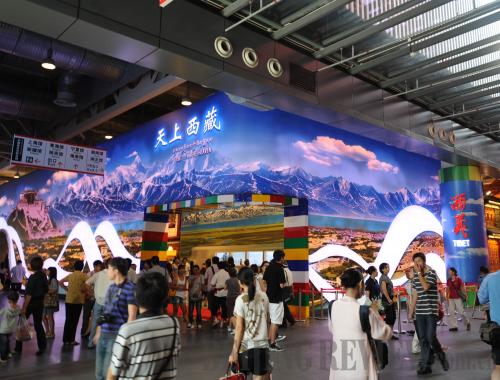|
 |
|
A POPULAR PAVILION: Visitors flock to the Tibet Pavilion on September 5. More than 4 million people have visited the pavilion since the opening of the World Expo in Shanghai (CHOGO) |
The Tibet Pavilion provides a rare glimpse into the natural beauty and cultural majesty of Tibet. Tian Fuli, Director of the Tibet Pavilion at the World Expo in Shanghai, spoke about the pavilion with Expo Weekly.
Expo Weekly: Can you tell us about some of the exhibits in the Tibet Pavilion that help to shed light on this mysterious region?
Tian Fuli: Tibet's beauty lies in its natural landscape and the unique ethnic culture. It is also embodied in the changes in the ways of life for the residents of Tibet, as well as the progress made by Tibet's numerous ethnic groups. We created exhibits related to all these aspects for our pavilion, because these are what interest our Chinese and foreign visitors the most.
The Tibet Pavilion is intended to display how Tibetans are engaged in environmental and ecological protection, carrying on their ethnic cultural heritage and promoting sustainable development. The pavilion showcases Tibet's remarkable social and economic progress over the last several decades. The Tibetan people have a grand vision for the year 2020; they wish to build Tibet into a well-off and harmonious society, as well as an environmentally protected region.
How has life improved for the Tibetan people over the last several decades?
The old Tibet was a feudal serfdom society before the democratic reform in 1959. At that time, the majority of Tibetan residents led a miserable life in this sparsely-populated region, with adverse weather conditions adding to their misfortunes. However, after the democratic reform, the region has taken on a completely new look; living standards of the ordinary people have been drastically lifted since China's adoption of the reform and opening-up policy in 1978. In recent years, the Tibet Autonomous Regional Government has made special efforts to improve the living conditions of local nomadic households. As a result, many herdsmen and their families have moved into new houses in urban areas. They no longer have to wander from one pasture to another; youngsters may concentrate on their studies while their elders can enjoy a relatively carefree, stable life. As the pace of urbanization speeds up in Tibet, more and more residents have come to learn of the comforts and conveniences that urban life can bring.
Another improvement is the extensive use of solar energy by Tibet's inhabitants. In both urban and rural areas across Tibet, solar power is widely and effectively used for generating electricity, as well as for cooking and bathing. In addition, there is a growing awareness of the concept of sustainable development among Tibetans; many have taken the initiative to protect their local environment. The Central Government has set a regional development goal with the hope of creating a generally well-off society by the year 2020.
How has Tibet benefited from being showcased through its pavilion at the World Expo?
I think the World Expo offers a rare opportunity for Tibet to be presented to the outside world. Some of the concepts that the World Expo advocates, such as protecting the environment and lowering carbon emissions, echo movements that the local government has called for and encouraged in the past. The World Expo in Shanghai will help people in Tibet to keep these concepts in mind in their daily lives. At the same time, by featuring some of the eco-friendly products and specialty goods from Tibet at the World Expo, we hope that we will have more opportunities to broaden our market both in and outside China. We want people from outside of Tibet to share the wonderful life that we've made in the Tibetan highlands.
The Tibet Pavilion is very popular at the Expo. In addition to its exhibits, are there any plans for activities or other attractions at the pavilion?
We have staged several small-scale cultural shows with strong ethnic flavor. They have featured Tibetan drama, traditional yak dances, instrumental performances featuring the xianzi—a Tibetan musical instrument—and performances of Tibetan folk ballads. We have also had tangka painting demonstrations; these are an excellent example of traditional Tibetan art. These events were warmly received by our visitors.
| 